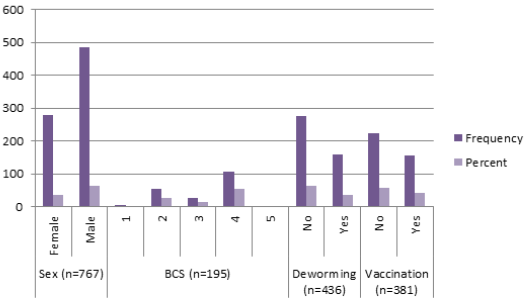Research Journal for Veterinary Practitioners
Case Report
Different Clinical Conditions and Evaluation of Factors Responsible for Myiasis in Pet Dogs in Bangladesh
Muhammad Sahidur Rahman1*, Saroj Kumar Yadav1, Tanjilla Hasan1, Avijit Dutta1, Sharmin Chowdhury1, Sudeb Sarkar2
1Chittagong Veterinary and Animal Sciences University (CVASU), Bangladesh; 2Chittagong Veterinary and Animal Sciences University, Khulshi, Chittagong-4202, Bangladesh.
Abstract | The study was conducted to evaluate the occurrence of different diseases and disorders in pet dogs visited at SAQ teaching veterinary hospital at Chittagong Veterinary and Animal Sciences University (CVASU) during the two years period from July 2013 to June 2015. A total of 835 case sheets of dogs were recorded according to year the total dog in 2013, 382 in 2014 and 252 the year 2015.In regards to month, the highest number of dog was visited during January & the lowest were in October. Among different breeds highest percent were local breeds 22%, followed by cross breeds 15%. Different foreign breeds were Shephard 8%, Spitz 4%, Samoyed 3%, Lassa 1%, & Labrador 1%. All these cases were not diseased animals, some were healthy just came for vaccination and regular check up. Among diseased cases, the highest occurrence was observed of parasitic problems (both ectoparasites and endoparasites combined 163 cases). Individually, ectoparasitic problems were higher than these of endoparasites. A total number of cases with wounds was 43 where dog bite wound were 23. A wide variety of viral and Bacterial diseases and a mixture of infections, surgical cases were castration, spaying (Hysterectomy), fractures and Healthy cases were check up and vaccination of dogs. Individually highest occurrences were recorded for myiasis, total 39 cases. The occurrence of myiasis was analyzed on the basis of sex, year, season, population, de-worming and vaccination to identify the responsible factors. Occurrences found higher in summer and year 2014 with significant P-value (P ≤ 0.05) but in myiasis the relation of sex, de-worming and vaccination were not significant (P > 0.05). The high frequencies of parasitic problems suggest a poor husbandry practice of pets in Chittagong city and it gives a hint that the risk of zoonotic infection through canine intestinal parasites may be high in Bangladesh. In considering this study, an appropriate control strategy should be designed and applied to prevent these diseases and/or conditions in pet dogs and to protect the public health from zoonosis.
Keywords | Occurrence, Myiasis, Dog, risk factors, Zoonosis
Editor | Kuldeep Dhama, Indian Veterinary Research Institute, Uttar Pradesh, India.
Received | March 07, 2017; Accepted | April 01, 2017; Published | September 22, 2017
*Correspondence | Saroj Kumar Yadav, Chittagong Veterinary and Animal Sciences University (CVASU), Bangladesh; Email: shirfraaz@gmail.com
Citation | Rahman MS, Yadav SK, Hasan T, Dutta A, Chowdhury S, Sarkar S (2017). Different clinical conditions and evaluation of factors responsible for myiasis in pet dogs in Bangladesh. Res. J. Vet. Pract. 5(3): 28-33.
DOI | http://dx.doi.org/10.17582/journal.rjvp/2017/5.3.28.33
ISSN (Online) | 2307-8316; ISSN (Print) | 2309-3331
Copyright © 2017 Rahman et al. This is an open access article distributed under the Creative Commons Attribution License, which permits unrestricted use, distribution, and reproduction in any medium, provided the original work is properly cited.
INTRODUCTION
The domestic dog (Canis lupus familiar) has become a crucial part of the Modern family. Dogs have diversified utility ranging from tracking, hunting, weapons and bomb detecting squad healer of both physical and emotional problems of humans, detecting criminals and guiding blind people. Humans benefit from dog rearing both physically and mentally (Ownby et al., 2002; Friedmann et al., 2009; Walsh et al., 2009). Pet dogs play also a risk to public health due to bites, scratches to human beings (Hongoh et al., 2011). Minimum 36 important zoonotic diseases are spread from dogs worldwide, although the occurrence of some important zoonotic diseases derived from dogs has reported from Bangladesh but the inland reports on this aspect are very limited (Tarafder and Samad, 2010). Vector-borne and zoonotic diseases spread where and when vectors, animal hosts, pathogens, and susceptible human populations overlap, Canine vector-borne diseases including anaplasmosis, babesiosis, bartonellosis, borreliosis, dirofilariasis, ehrlichiosis, leishmaniosis, and rickettsiosis (Savić, S. et al., 2014). Myiasis Greek myia means “fly” (Shinohara et al., 2004) is the term used to illustrate a maggot infestation. Maggots are fly larva that nourishes on necrotic and failing tissue. Especially prone are those dogs confined to the outdoors with situations in which their skin remains moist. In pets, predilection sites for flies can be included bite wounds, areas of fur that are soiled with urine and feces, skin folds, infected ears, ruptured skin, hot spots and surgical incisions. This applies especially to weak and debilitated dogs. The blowfly lays many eggs on decaying, infected or inflamed tissue. In favorable weather (warm and moist) the eggs hatch within 24 hours. The larva uses its specialized mouthparts to pierce the skin. They make a tunnel into the rectum or vagina. With time, the maggots can start releasing toxins that can make your pet sick very quickly, leading to fever, lethargy, and shock. Myiasis infestations cause irritation, an annoyance to animals and disruption of normal habits including resting, feeding, and digestion. With a severe infestation, the dog could go into shock. The shock is caused by enzymes and toxic substances secreted by the maggots. Based on location of maggot infection, it is a medical emergency and requires immediate veterinary attention. The most frequent host for myiasis is cattle and goat (46.4%), followed by dogs (15.3%), humans (14.7%), pigs (6%), horses (4%) and sheep (1%) (Sergio et al., 2007). There is very limited research was found with a view to exploring the prevalence and responsible risk factors of myiasis of a dog in Bangladesh.Veterinary hospital register data which is very rare in veterinary medicine, in particular in Bangladesh was used to describe the epidemiology of Different diseases of dogs. Systematized collection, emergence, and analysis of patient record data from Shahedul Alam Qadri teaching veterinary hospital have been planned for generation of trustworthy prevalence data involving to the overall dog population. Contemporaneous recording of clinical information by veterinary health professionals during episodes of care for every patient treated minimizes selection and recall biases in primary-care practice data (Germinal et al., 2013). By contrast, referral caseloads may show selection bias towards more complicated disorders (Fleming et al., 2011), questionnaire surveys may incur selection, recall and misclassification biases (Adams et al., 2010).
MATERIALS AND METHODS
Ethical Approval
Ethical approval was not important because all the animals under this research were clinical cases and were examined, diagnosed and treated as per standard treatment and examination procedure.
Study Area
The study was conducted in SAQTVH (Shahedul Alam Quaderi Teaching Veterinary Hospital), Chittagong Veterinary and Animal Sciences University, Khulshi, Chittagong. Dogs in and around Chittagong city suffering from any disorders were selected for the study and cases mostly presented for treatment to SAQTVH.
Duration Of The Study
The duration of the study was two year from July 2013 to June 2015, (last 6 months of 2013, whole 2014 and first 6 months of the year 2015).
Reference Population
Total 835 dogs (diseased and non diseased) that were brought in SAQTVH during two years of study duration were considered to be reference population.
Data
For this study the SAQTVH, CVASU patient case sheet data was used for any dogs that were bought during July 2013 to June 2015. A total of 835 dog patients data were included in this study that were registered at SAQTVH, CVASU.
Method Of Collection
All the dogs brought for treatment in SAQTVH, were first registered in the patient registered book and each patient contain a unique registration number. The date, complaint of the owners, age, sex, breed diseases and rugs used for treatment were recorded in individual patient case sheet. All the data that were collected (categorical variables like breed, season, body area etc. and continuous variables like age, BCS etc.) were entered into MS excel (Microsoft office excel-2007, USA).
Data Management
The different breeds include Samoyed, German shepherd, Labrador, spitz, Deshi, Dachshund, Pug, Lassa, Golden retriever, Doberman, Rottweiler & cross breeds. Breeds with significant in number counted separately and which are rarely visited like pug, Dachshund etc combined counted as others. The year was divided into two seasons namely summer and winter according to the climate of Bangladesh. Wide varieties of diseases and disorders were recorded in 835 pet dogs. Here only those diseases are listed which had at least 3 patients during the 2 years of study periods. Disease and/or conditions with less than 3 cases are not shown here individually but includes in term ‘others’, among those some important diseases are mastitis, pasturellosis, corona viral infection, leptospirosis, nutritional diseases etc. All gastrointestinal parasitic infections were listed as endoparasitic infections but anchylostomiasis & ascariasis tabulated separately. Same as internal parasites, all external parasitic problems like pyoderma, flea infestation are included within the value of ectoparasitic infestation except few common problems like flea allergic dermatitis,mange, myiasis, pediculosis. In dermatitis cases Flea allergic dermatitis was common. Among protozoal infection only toxocariasis recorded as individually and protozoan diarrhea includes in total diarrheal cases. Different types of wounds like lacerated wound, accidental wound, and mischief wound are shown under common parameter as wound, although bite wounds are placed separately due to its significance in public health. Among dental problems only gingivitis were recorded. Some urinary tract infection is also found. Different digestive disorders common in SAQTVH were gastritis, vomition, anorexia, diarrhea & constipation. Surgical cases like castration, spaying and fractures are shown separately but others like tumor, complication of docking, spaying had less than 3 frequency. In case of health check up and vaccination clinical examination was performed on the pets for soundness. Viral diseases were found as rabies, parvoviral infection, canine distemper and bacterial were mainly Kennel cough, pneumonia and enteritis. Some reproductive disorders were metritis, Canine transmissible venereal tumor,anestrous and respiratory infections were pneumonia, coughing, common cold.Different eye problems were mainly corneal opacity, conjunctivitis and keratitis, shown here in total.
Epidemiological Analysis
All cases were analyzed as per different season, breeds, age and sexes in order to conduct an epidemiological analysis on the basis of clinical diagnosis. Data analysis was done by STATA version-12.1 (STATA Corporation, College Station, Texus, USA). Descriptive analysis was done by means of creating histogram, line graph and pie charts. To identify the association between a categorical explanatory variable with the outcome (occurrence myiasis), chi- square (χ2 test) test was performed. An association was regarded as significant if the p value was <0.05.
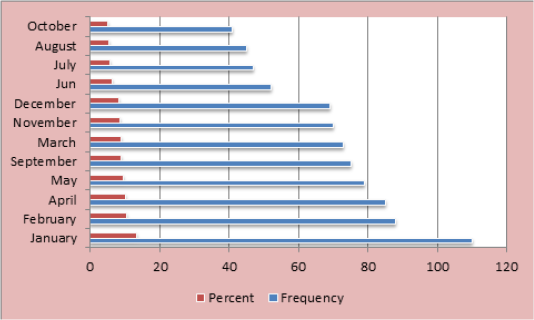
Figure 1: Frequency and percent of patients (dogs) visited the SAQTVH in different months across 2013-2015
RESULTS AND DISCUSSION
(Figure 1). During the two years period from July 2013 to June 2015 (last 6 months of 2013, whole 2014 and the first 6 months of 2015) a total of 835 case sheets of dogs were recorded. According to year the total number of dogs was 200 in 2013, 382 in 2014 & 252 in the year 2015 (Figure 3). In case of month the highest number of dogs was visited in January, then February, followed by April and May. The lowest number visited the hospital in October and second lowest in August followed by July and June (Figure 1). The patients’ loads were lowest in mid of a year then gradually increased in last of the year and became highest at the start of a year (Figure 2).
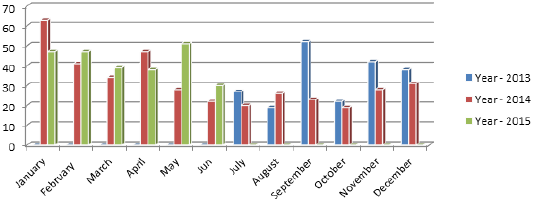
Figure 2: Frequency and percent of patients (dogs) visited the SAQTVH in different months according to the years 2013-2015
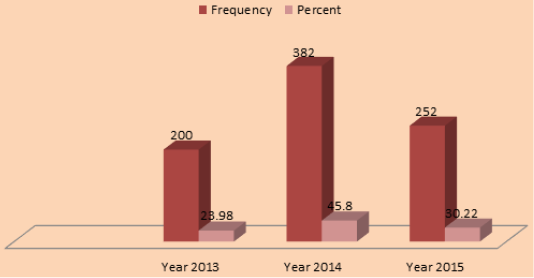
Figure 3: Frequency and percent of patients (dogs) visited the SAQTVH in different years (2013, 2014, and 2015)
(Figure 3). During the 24 months study period many different breeds of dogs visited the SAQTVH. Percentages showed highest percent were local breeds 22% followed by cross breeds 15%. Others were Shepherd 8%, Spitz 4%, Samoyed 3%, Lassa 1%, & Labrador 1%, others 3% and 43% breeds were not identified specifically (Figure 4).
Among 835 cases, 63% were male and 37% were female (Figure 5). Only 36% and 41% patients were found dewormed and vaccinated, respectively. Majority (54%) of the animal’s body condition was good (BCS 4) (Figure 5). Analysis showed that a wide variety of diseases were encountered at the SAQTVH during the study period among dog patients. It was revealed that highest number of dogs was visited the hospital with parasitic problems (163 cases together with ecto and endo parasites), and among all, ectoparasitic problems had higher occurrence than those of endoparasites. Total ectoparasitic infestations were 103 cases which includes maggot infestation (myiasis) 39 cases, mite (mange) 11 cases, lice (pediculosis) 4 cases, tick 9 cases & other ectoparasites 40 cases. Total endoparasitic infections were 60, with anchylostomiasis 8 cases & ascariasis 6 cases. Under protozoan parasitic infections, 10 toxocariasis and some protozoan diarrheal cases were encountered during the study period. Only 3 cases of fungal infection were found in 2015. (Table 1) Among the viral diseases, 21 parvoviral infections, 10 rabies cases & 3 canine distemper cases were observed. Digestive disorders found as gastritis - 23, enteritis - 6, diarrhea - 5 & constipation – 3 patients. Moreover 6 kennel cough and 4 pneumonia cases were observed. The frequency of other diseases can be found in Table 1. Total number of wounds encountered as 43 of which dog bite wound 23 & other wounds 20. Surgical cases encountered during the study period were, 4 castration, 6 ligation & 14 fracture surgery. Among non diseased cases, general checkup - 18 & vaccination - 122 dogs were recorded .Among all diseases highest frequency were recorded for myiasis. 39 myiasis cases were recorded of which 4 cases were found during the study period of 2013, 25 in 2014 & rest 10 during first half of the year 2015.
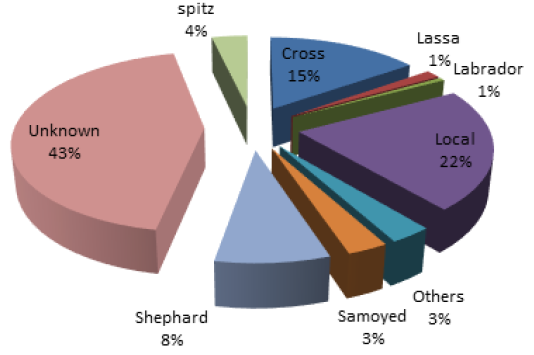
Figure 4: Pie chart showing the percent of dogs belongs to different breeds attended SAQTVH during the years 2013-2015
Table 1: Frequency of dogs attended the SAQTVH with different physical problems in different years
| Clinical problems | Year 2013 | Year 2014 | Year 2015 | Total |
| Anchylostomiasis | 0 | 3 | 5 | 8 |
| Allergy | 0 | 2 | 1 |
3 |
| Alopecia | 1 | 4 | 0 | 5 |
| Anemia | 4 | 2 | 0 | 6 |
| Anorexia | 6 | 2 | 1 | 9 |
| Ascariasis | 2 | 2 | 2 | 6 |
| Bite wound | 2 | 12 | 9 | 23 |
| Canine Distemper | 1 | 0 | 2 | 3 |
| Castration | 2 | 0 | 2 | 4 |
| Check up | 1 | 10 | 7 | 18 |
| Constipation | 2 | 1 | 0 | 3 |
| Dermatitis | 15 | 6 | 3 |
24 |
| Diarrhoea | 3 | 2 | 0 | 5 |
| Ectoparasite infestation | 8 | 18 | 14 | 40 |
| Endoparasitic infection | 10 | 20 | 16 | 46 |
| Enteritis | 2 | 2 | 2 | 6 |
| Eye problem | 3 | 1 | 2 | 6 |
| Fracture | 2 | 8 | 4 | 14 |
| Fungal infection | 0 | 0 | 3 | 3 |
| Gastritis | 1 | 10 | 12 | 23 |
| Kennel cough | 1 | 4 | 1 | 6 |
| Lameness | 5 | 2 | 3 |
10 |
| Ligation | 1 | 2 | 3 | 6 |
| Mange | 3 | 8 | 0 | 11 |
| Myiasis | 4 | 25 | 10 | 39 |
| Others | 59 | 97 | 44 | 200 |
| Parvo viral infection | 3 | 11 | 7 | 21 |
| Pediculosis | 0 | 4 | 0 | 4 |
| Pneumonia | 2 | 2 | 0 | 4 |
| Pregnancy related problems | 3 | 9 | 5 | 17 |
| Rabies | 8 | 0 | 2 | 10 |
| Systemic infection | 8 | 3 | 1 |
12 |
| Tonsilitis | 0 | 2 | 3 | 5 |
| Toxocariasis | 0 | 6 | 4 | 10 |
| Tick infestation | 0 | 6 | 3 | 9 |
| Urinary tract infection | 0 | 3 | 1 | 4 |
| Vaccination | 24 | 48 | 50 | 122 |
| Wound | 7 | 9 | 4 | 20 |
| Total | 193 | 346 | 226 |
765 |
Comparative Occurrence Of Myiasis
Sex, year, season, population, de-worming and vaccination wise prevalence: The sex, year, season, population, Vaccination and de-worming specific prevalence of myiasis is shown in Table 2. The prevalence of myiasis was significantly (p<0.05) higher in summer season (6.84%) than in winter (2.44%). Moreover, slightly more females were affected (5.00%) with this disease than the male (4.52%). However, dogs that were not under de-worming were very much prone to myiasis (5.43%). Different continuous variables like age of pets, body weight & population (total number of dogs reared by an owner) were evaluated to estimate their effect on myiasis. It was observed that none of the variables had any significant effect on the occurrence of myiasis. However, an increased mean body weight had a significant relationship with the outcome at 10% level of significance (p ≤ 0.01) (Table 3).
Table 2: Effect of categorical variables on occurrence of Myiasis among dogs attended at SAQTVH (tested using chi square test)
| Variable | Level | Number of observation | Number positive (%) | P-value |
| Sex | Female | 280 | 14 (5.00) | 0.76 |
| Male | 487 | 22 (4.52) | ||
| Year | 2013 | 200 | 4 (2.00) | 0.03 |
| 2014 | 382 | 25 (6.54) | ||
| 2015 | 252 | 10 (3.97) | ||
| Season | Summer | 424 | 29 (6.84) | 0.003 |
| Winter | 410 | 10 (2.44) | ||
| Population | 0-2 | 76 | 4 (5.26) | 0.64 |
| 3-11 | 343 | 14 (4.08) | ||
| Deworming | No | 276 | 15 (5.43) | 0.26 |
| Yes | 160 | 5 (3.13) | ||
| Vaccination | No | 224 | 8 (3.57) | 0.66 |
| Yes | 157 | 7 (4.46) |
Table 3: Effect of continuous variables on occurrence of Myiasis among dogs attended at SAQTVH (tested using t-test)
| Variables | Presence of Myiasis | Mean | SE | 95% CI | P-value |
| Age (month) | No | 23.50 | 1.16 | 21.22-25.78 | 0.62 |
| Yes | 20.84 | 3.10 | 14.51-27.17 | ||
| Body weight (Kg) | No | 10.05 | 0.32 | 9.40-10.70 | 0.08 |
| yes | 12.87 | 2.13 | 8.43-17.31 | ||
| Population | No | 1.7 | 0.08 | 1.60-1.92 | 0.56 |
| yes | 2.00 | 0.42 |
1.09-2.90 |
This study showed that in the study area, highest number of dogs are suffering with parasitic problems (163 cases among 835 total number of cases) which agreed with the results of (Parvez et al., 2014) where using the register data of SAQTVH they reported highest prevalence of parasitic diseases (15.74%) in dogs in the study area. These results also concordant with (Tarafder and Samad, 2010) and (Chaudhari and Atsanda, 2002) where highest prevalence of parasitic diseases in dogs was reported comparing with other diseases. Number of ectoparasitic cases was 103 which were higher comparing the endoparasitic diseases (60 cases). (Parvez et al., 2014) showed that ectoparasitic problems are higher than the endoparasitic diseases in dogs and this study also found that pet dogs having highest prevalence of arthropod infestation (22.62%), followed by internal parasites (14.80%), after that wounds cases were 43 in total where 23 were dog bite wounds which indicates risk of public health. approximately 90% of human rabies cases are resulted from dog bites in Indo-Bangladesh sub-continent. This revision recorded 10 rabies cases in pet dogs which point out the potential risk to pet owners. Then occurrence of digestive disorders (total 37) were also found high and it is comparable to (Parvez et al., 2014) and (Tarafder and Samad, 2010) showed 12.34% and 10.22% disease prevalence of digestive system in dogs, respectively. This study recorded different surgical cases of dogs as 4 castrations, 6 ligation & 14 fracture surgery with similarity of the results of (Parvez et al., 2014) stated general surgery (17.28%), special surgery (2.77%) and orthopedics (3.7%) in SAQTVH. Among non diseased cases vaccination and check up were recorded 122 and 18 respectively compare with (Parvez et al., 2014) his study also found vaccination and check up 80 (24.69%).
Myiasis is the most familiar and widely distributed disease in Chittagong, Bangladesh (Imtiaz et al., 2014). This study found 39 myiasis patients and it is the highest among individual diseases. This high number may be due to higher amount of wounds recorded as 43 cases during this study period. Wounds with foul odor, swelling, vesicle and abscess by bacterial contamination were the most crucial risk factors for myiasis (Imtiaz et al., 2014). Literatures on myiasis in dogs are not available in Bangladesh but few resources present on myiasis in livestock only. The higher occurrence of myiasis in dogs is supported by (Imtiaz et al., 2014) where his study area was Chittagong city and reported myiasis in goat 69%, cattle 22%, dog 7%. The prevalence of myiasis was higher in summer season (6.84%) than the winter (2.44%) (P<0.05) This results also supported by (Juyena et al., 2014) they mention, myiasis frequently observed from March to June (80%). This study found females were mostly affected (5.00%) with this disease than the males (4.52%); (Radfar and Hajmohammadi, 2012) reported the same, but their relationship was statistically insignificant. However, (Cramer et al., 2002) found adult, light and short haired pure male dog breeds were mostly infested, it’s may be due to geographic location and seasonal variations. However the present study provides valuable information on disease occurrence in dogs for the pet owners and veterinarians that parasitic diseases are highly prevalent health problems in pet dogs. So that proper management, vaccination, awareness making among the pet owners are necessary for the prevention and control of these disease conditions in dogs, and humans.
CONCLUSION
The SAQ teaching veterinary hospital(SAQTVH) case sheet data were used for the epidemiological studies to understand the frequency and pattern of the pet Dog visited in and there different diseases & disorders, with associated risk factors analysis of myiasis in dog. As the SAQTVH is a well established veterinary hospital in Chittagong metropoliton city so this study may reflect the condition of pet dogs of this city as well. The conducted study suggests that occurence of parasiric diseases were highest, as there is no available practices of using regular de-worming schedule and hygienic management of pet dogs in Bangladesh especially in Chittagong. So regular anthelmentic drugs administration may be recommended for all pet dogs. Analysis showed viral diseases also found in higher amount, as there is no antiviral drugs. It could be stated that rabies is a very much fatal zoonotic disease. So all pet owners, veterinarians and associated people should be suggested to be performed regular vaccination. Result showed different surgical cases were available so these cases should be handled carefully and aseptically to prevent further bad consequences. Significant amount of myiasis recorded in this study area indicate poor sanitary conditions of pet housing and lees consciousness of owners about their pet health. It recommended that diagnosis of any wounds and proper treatment should be done in early basis to prevent myiasis problems in pets as well as improved their managemental practices to prevent and protect various types of clinical diseases. In a brief, it could be stated that the risk factors, descriptive epidemiology, showed in this report, will be beneficial for small animal practitioners and researchers who will attempt to further analysis of data to compare current and previous infections. It is required to introduce a program to educate the public on zoonotic diseases of pets and their role of risk to public health.
ACKNOWLEDGEMENT
Special thanks to Hospital authority and Department of Medicine Surgery
AUTHORS CONTRIBUTION
Saroj Kumar Yadav and Sahidur Rahaman prepare manuscript and data collection and Tanjilla Hasan, Avijit Dutta and Sudebsarkar helped for data collection and data input in excel, Sharmin Chowdhury did data analysis.
REFERENCES



